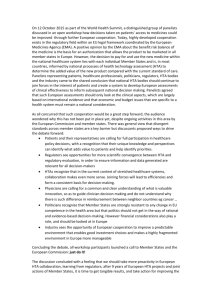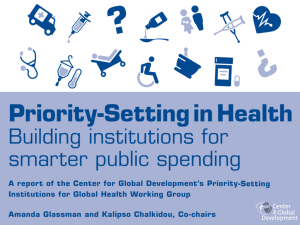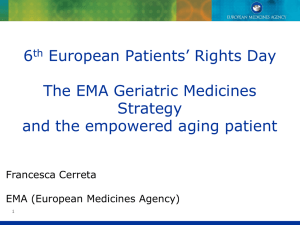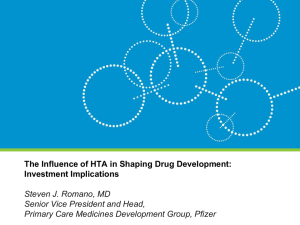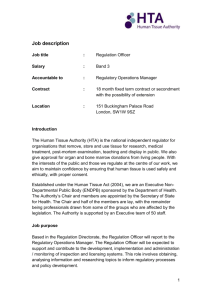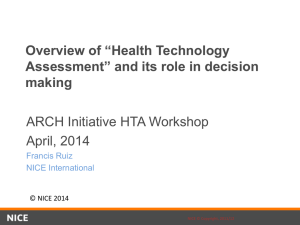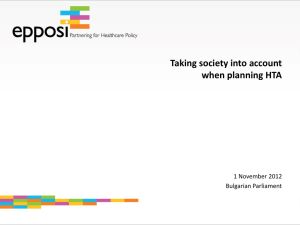Evidence based medicine (1)
advertisement
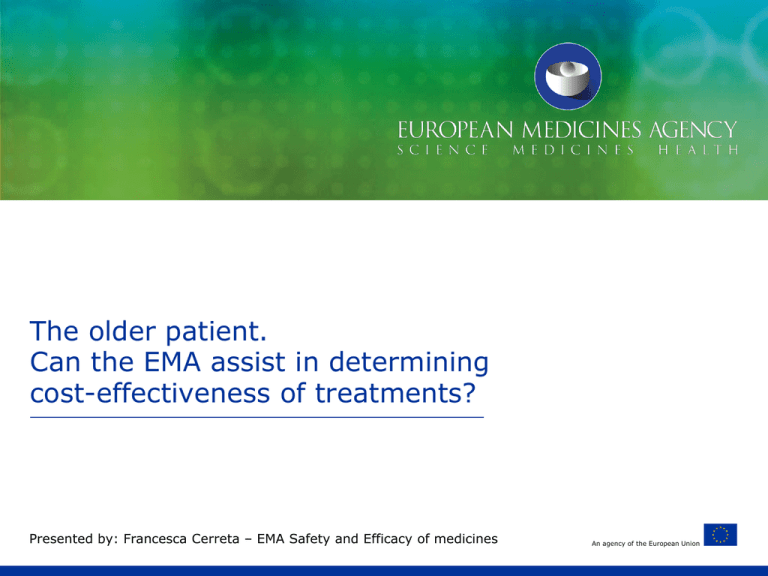
The older patient. Can the EMA assist in determining cost-effectiveness of treatments? Presented by: Francesca Cerreta – EMA Safety and Efficacy of medicines An agency of the European Union What does EMA do? The Agency is responsible for the scientific evaluation of applications for medicines in the European centralised procedure. This benefit-risk assessment forms the basis for EU marketing authorisations. What do HTA bodies do? HTA bodies carry out their own assessments of medicines once they have received a marketing authorisation. HTA bodies compare the relative effectiveness of medicines and take their financial cost into account. This can lead to differences in the types of studies needed to support the assessment carried out by regulators and HTA bodies. 1 2 (legal requirements, regulatory guidelines, scientific advice received) Constraints (from pharmaceutical, nonclinical and clinical development including publications) Project-specific data (compounds with same/ similar MoA, recent assessment procedures, etc.) Precedents Defining a Strategy Generate data for Regulatory Approval and Health Technology Assessment Development strategy to achieve the Target Product Profile EMA / HTA Dialogue • Mandate from High Level Pharmaceutical Forum in 2008: EMA, Member States and HTAs should cooperate so that Assessment Report can contribute to relative effectiveness assessment (EPAR improvement project) • Cross Border healthcare directive 2011/24/EU: support of the collaboration activities of the voluntary network of HTA agencies • Exchange on scientific / methodological principles between Regulators and HTAs beneficial to avoid double-standards: • Parallel Scientific Advice/Early dialogue • Consultation on Guidelines (now routine) • Relative effectiveness assessment • Databases for post-marketing data generation • Specific measures for orphan medicines 3 Parallel HTA-EMA Scientific Advice - examples Diabetes, Heart Failure, Alzheimer’s, Depression, Lung Cancer, Breast Cancer, Melanoma, Pancreas-Ca, Mesothelioma Asthma, Rheumatoid Arthritis Multi-resistant Infections, Food Allergies Orphan conditions • The majority had new mechanisms of action (new monoclonal antibodies, new chemicals, tumour vaccines) • HTAs and payers from UK, Sweden, France, Italy, Netherlands, Spain, Germany, Belgium • 14 big companies, 2 SMEs 4 Topic Areas 5 5 First experiences with Parallel Regulatory/HTA Scientific Advice Note: based on first 11 procedures. Some discussion examples •Is impact to the caregiver an important piece of the value proposition when evaluating a treatment for prodromal Alzheimer’s disease? •Advice on selection of instruments in the clinical trial to capture the burden to the caregiver (Dependence Scale)? •Value of MRI imaging as indicator of progression of atherosclerosis? •If final data on cardiovascular events cannot be provided for diabetes preauthorisation what alternatives are there for the company from the Regulators and HTA point of view? •The cost-effectiveness of the product will be strongly influenced by the extent to which treatment prolongs the prodromal Alzheimers disease phase, delaying progression to more costly states associated with potentially lower quality of life and greater cognitive impairment. This would potentially result in a greater proportion of residual life being spent with lower disability and lower medical costs. However, delaying progression may also extend life expectancy and time in the moderate and severe disease states, which could result in higher total lifetime costs and reduce the cost-effectiveness of treatment. Modelling will be necessary to project out the implications of potential post-trial scenarios. Advice on approaches taken to establish the most plausible scenario and required 6 analyses to support the plausibility of the scenario? What about older patients? Cardiovascular drugs % of total patients treated with CV drugs (2011) * % of patients in clinical trial population ( CV drugs approved 2009-2012) % of patients in clinical trial population (excluding thromboembolism) 80 70 60 % 50 40 30 20 10 0 Age 0-64 65-74 75+ * Extracted from "L'uso dei farmaci in Italia 2011" and Italian census 2011 • Major consumers of medications • ADRs hospital admissions significantly higher in older people • Incidence on pharmaceutical and healthcare costs - sustainability 7 EMA Geriatric medicines strategy (2011): TWO PRINCIPLES Medicines used by geriatric patients must be of high quality, and appropriately researched and evaluated.. for use in this population. Improve the availability of information on the use of medicines for older people 8 Evidence based medicine Informed prescription Evidence based medicine (1) Potential questions • • • • • Is the clinical trial population representative of real-life? Cost-effectiveness over established (generic) comparator What do we know about the risk of polymedication? Will frail patients have the same benefit/risk profile? Costs and benefits for individual and society? Challenges • • • • Balancing risk of involving frail/older patient in clinical trials Creating an “orphan” older population? (not authorising/not reimbursing) Design appropriate pharmacovigilance for unknowns Communicating to reduce inappropriate prescription The EMA has not so far received a parallel SA/HTA request on elderly (except Alzheimer) BUT Our mission is to make sure that medicines are assessed as safe and effective for the population of use, and the assessment results are communicated appropriately 9 Evidence based medicine (2) Assessment report- geriatric tables (Under amendment after initial experience/feedback (CHMP/PRAC/SA group)) Take home messages: eCTD Module Age 65-74 Age 75-84 Age 85+ number / total number (all ages) number / total number (all ages) number / total number (all ages) Efficacy and Safety Studies Human PK Studies 1) Qualitative not statistical- focus attention of reviewer on available data in relation to epidemiology of disease 2) Adaptations might be appropriate depending on product/disease 3)statements made after consideration of these data should be meaningfully reflected in the product information. Human PD Studies Biopharmaceutical Studies MedDRA Terms Total ADRs Serious ADRs – Total - Fatal - Hospitalization/prolong existing hospitalization - Life-threatening - Disability/incapacity - Other (medically significant) AE leading to drop-out Psychiatric disorders Nervous system disorders Accidents and injuries Cardiac disorders Vascular disorders Cerebrovascular disorders Infections and infestations Quality of life decreased Sum of postural hypotension, falls, black outs, syncope, dizziness, ataxia, fractures Age <65 Age 65-74 Age 75-84 number number number Age 85+ number (percentage) (percentage) (percentage) (percentage) Evidence based medicine (3) Guidelines • Geriatric Expert Group and HTAs will routinely comment on guidelines prior to their release. • Points to consider on Frailty should be developed. • Geriatric formulations guideline under development Scientific Advices/Scientific Advisory Groups • Geriatricians have been involved in a number of these • A member of the GEG is now member of the Scientific Advice working Party Evidence based medicine (4) New EU pharmacovigilance tools Tools relevant to reaching to real-life: • Legally binding Risk Management Plans for all new products • Legally binding post-authorisation safety studies, when justified • Legally binding post-authorisation efficacy studies, when justified • Confirm a risk • Quantify a risk • Fill a knowledge gap, eg. efficacy in sub-groups • Off-label use • Measure the effectiveness of risk minimisation • Legal responsibility to measure the effectivess of risk minimisation 12 Informed prescription(1) • EPAR to provide clear information, including to HTA bodies • SmPC and PIL to reflect in a significant way: • • • • • • Reflect clearly what is known. Be relevant on: Drug-drug and drug-disease interactions (cross refer) Dose adjustment (cross refer) Administration/ no crushing (cross refer) Need for follow up foreseen in RMP Informed prescription(2) • Risks of antipsychotics in people with dementia • Two safety bulletins sent by MHRA…. any atypical Quarter typical 07/11-09/11 04/11-06/11 01/11-03/11 10/10-12/10 07/10-09/10 04/10-06/10 01/10-03/10 10/09-12/09 07/09-09/09 04/09-06/09 01/09-03/09 10/08-12/08 07/08-09/08 04/08-06/08 01/08-03/08 10/07-12/07 07/07-09/07 04/07-06/07 01/07-03/07 10/06-12/06 07/06-09/06 04/06-06/06 01/06-03/06 10/05-12/05 07/05-09/05 04/05-06/05 01/05-03/05 10/04-12/04 07/04-09/04 04/04-06/04 01/04-03/04 Percent (%) of patients with dementia prescribed an antipsychotic Antipsychotics: advice to avoid use in dementia 30 25 20 15 10 5 0 Thank you 16

